
This article appeared in the Vol. 20 No. 2 / Fall-Winter 2013 issue of West 86th.
Within the framework of an overall theory of the cultural history of materials, this article reconstructs the role of tempered glass in the modernist imagination, from architecture (Giuseppe Terragni’s Danteum and Casa del Fascio) to the Gläserne Mensch (Glass man) and Gläserne Frau (Glass woman), the stars of the German Hygiene Museum in Dresden.
The history of materials is one with the history of civilization. From Hesiod’s Works and Days with its succession of gold, silver, bronze, and iron ages, to proclamations of modern times as the era of steel, aluminum, plastics, and silicon, materials are the very stuff of culture. Or, rather, they body forth the tangled fabric of beliefs, ideas, imaginings, exigencies, rituals, and social practices that compose a culture in a variety of palpable, practical, immediate forms. The resulting act of translation is never frictionless. The malleability of materials is constrained both by their physical properties and by the limits of human imaginings. Materials are never simply spoken for within a given cultural-historical setting. They talk back. They talk back as they are being spoken for.
Songs of Matter is the provisional title of a larger project that I’ve been working on intermittently for over a decade, charting the channel running back and forth between materials and culture. Its title is cribbed from Maxime du Camp’s 1860 Chants de la matière, the Parisian poet’s naïve but earnest endeavor to forge a new poetry of steam and steel, but its timeline is mostly subsequent to the era of Du Camp.1 At its core, Songs of Matter consists in a history of the twentieth century written from the standpoint of some of the century’s defining materials: among them, asphalt, stainless steel, aluminum, tempered glass, rayon, corrugated cardboard, polystyrene, and synthetic paper. Each chapter hinges on the dialogue between cultural works and specific instances of design, engineering, and architectural practice. In the case of aluminum, the Bialetti Moka Express coffeemaker percolates nationalist narratives regarding Italian aviation and autarchy as it moves the consumption of espresso coffee from train station cafés to the stovetop.2 In the case of cardboard, Buckminster Fuller recasts his 1950s experiments with portable military shelters as humankind’s future Home in a Dome, performed to the tune of “Home on the Range.”3 In the case of plastics, Alain Resnais’s early documentary Styrene Song anchors an entire cosmology of consumption in the mysterious making of a plastic bowl.
The time slice in question is a single century, but a century during which a momentous shift occurs as materials migrate ever further away from disclosing their ties to the natural world and spin out into increasingly synthetic, artificial, more-than-natural orbits: orbits where they come into tension with commonplace assumptions regarding the powers and limits of the physical world.4 It is, accordingly, the century when the very notion of a science of materials is born as an interdisciplinary domain of research and field of professional endeavor; and a century in which the dominant narratives of revolution and change become closely intertwined with the histories of a legion of so-called miracle materials, mythologized by their creators and by the burgeoning culture of advertising and mass communications.
Crystalline Bodies is drawn from a chapter within this larger enterprise. It is an extract, which is to say, less and more than a single chapter: “less” inasmuch as I will limit myself to sketching out select portions of a broader argument; “more” to the degree that I begin by framing some hypotheses that stretch beyond the confines of the case study at hand. The case study begins with a thumbnail sketch of glass as a historical material, accompanied by a typology of its cultural meanings from antiquity until such time as the large-scale industrial production of architectural glass fundamentally reshuffles that system of belief: a sketch that particularly emphasizes imaginings of glass in poetry and narrative. At the center of the article, I pivot to consider two symptomatic twentieth-century episodes: the myth of fascism as a glass house actualized in Giuseppe Terragni’s Como Casa del Fascio and Danteum; and the tale of the Dresden Hygiene Museum’s Gläserne Mensch (or Glass Man) and his progeny.
But first, some methodological presuppositions that encompass the whole of Songs of Matter:
A: the physical properties of materials condition but do not determine the history of their uses and cultural meanings
B: materials form part of a network of relations; their meanings are produced by a system of contrasts, similarities, and oppositions
C: materials rarely displace one another; rather, a condition of simultaneity characterizes a culture’s system of materials; the arrival of new materials, therefore, prompts less a replacement than a reorganization of this system of relations
D: the human body and its sensory apparatus anchor every system of materials; materials are ultimately lived and imagined in a prosthetic relation to the body
E: as much as functional or physical properties, the values with which a given culture endows a material determine both the actual perception and the uses to which a material is put
F: old materials are born under the sign of nature
G: new materials are born under the sign of imitation: imitation of nature and/or of preceding materials that have become naturalized over time; they emancipate themselves from an imitative status only when they themselves become the objects of imitation
These are, naturally, sweeping assertions best tested against historical particulars. So to these let’s now turn by way of some reflections on the premodern assumptions that were overturned by the advent of industrial plate and float glass.
Glass in the Mirror of History
Glass is one of history’s most venerable materials, occurring in nature as obsidian, but traceable as an industry to the Near East in the sixteenth century BCE.5 In the course of the thirty-five centuries that precede the second industrial revolution, processes of glass manufacture remain relatively stable, as does the basic formula of sand mixed with soda and lime. They begin as techniques for ceramic glazing, followed by the marvering (or rolling) of hot coiled strips on stone to form small vessels, often completed by procedures of grinding and polishing. The development of high-temperature furnaces in sixth century BCE Mesopotamia marks a decisive shift, giving rise to glassblowing: a technique that gradually sweeps the world and persists largely unaltered until the present day and serves as the basis for the production of glassware and window glass well into the nineteenth century. This picture begins to shift only with the arrival in the mid-nineteenth century of the Bessemer process, which permitted the production of continuous ribbons of flat glass pressed between rollers, as well as of experiments with casting large glass plates on molten iron surfaces. Such techniques allowed for expanded surface areas, but the resulting sheets required extensive polishing to remove impurities and remained vulnerable to shattering. The true revolution in glass manufacture would have to await an array of twentieth-century techniques, from tempering via the use of chemical compounds to create compressive stresses that compensate for natural tensile stresses within large glass sheets, to the production of float glass by means of the Pilkington process (perfected in the 1950s). It is these that give rise to the vastly expanded universe of applications familiar to us today, including plate glass, glass blocks, laminated glass, shatterproof glass, safety glass, Pyrex, and fiberglass.
In spite of the many centuries it spans, the advances in glass-making techniques, and the resulting growth and diversification of glass industries, the time period preceding the advent of modern architectural glass may be reduced to a single epoch during which four givens inform the cultural imagination.
The first is the notion of glass as a simulacrum of naturally occurring crystals or jewels. In Akkadian texts, glass is poured lapis lazuli rather than “lapis lazuli of the mountains”; in ancient Chinese, it is kiachousi-tsung (or imitation rock crystal). Its debut in a Western scientific work occurs in Theophrastus’s Treatise on Stones, in which it figures as a liquid emerald or lapis. This long-standing affiliation with precious and semiprecious stones contributes to the identification of glass with higher forms of materiality (spiritual bodies) and their attributes, real or imagined: cleanliness, health, moral probity, resoluteness, magical powers, and strength. It also cements glass’s identification with architectures of light, whether reliant upon natural illumination (as in Gothic cathedrals) or artificial successors (illuminated façades, radiant buildings, cathedrals of light). This feeling of continuity with the mineral realm will be displaced only as twentieth-century glass architecture establishes the primacy of glass’s relation to metals, pushing what was once a secondary or tertiary relation (viz. the lead grill of gothic windows) to the fore as glass emerges as a strong and even structural material in the same family as aluminum and steel.
The second given is that, despite the valiant efforts of craftsmen to bleach out residual iron with antimony oxide, clear glass was the exception throughout much of the material’s history. Dreams of crystalline transparency arose in a world in which crystalline transparency was a rarity, which is to say throughout the premodern era. Nearly all actual glass was opaque to semiopaque, tinted by impurities, filled with bubbles and imperfections. Seeing “through the glass darkly,” be it through a mirror, pane, or lens, was the norm in the preindustrial world, and exceptional objects endowed with high degrees of purity and transparency were viewed as magical or metaphysical objects: as higher expressions of embodiment.
The third given is that the scale of preindustrial glass objects was necessarily small, given that the maximum dimensions of the cylinders that even expert glassblowers could produce were 10 to 14 inches in diameter and 6 to 8 feet in length. Normative glass objects were experienced on the scale of the finger or the hand. The overall dimensions of the human body were understood as extending beyond the reach of glass as a material.
The fourth given is surely the most self-evident: namely, that glass is extremely brittle. Until the era of shatterproof glass, the perception of glass has been shaped by the certainty that, at any moment, a glass object can undergo sudden, unexpected, and catastrophic failure. The surface flaws that contribute to shattering are often invisible to the naked eye. No visible plastic deformation of a glass object warns of the imminence of disaster. Metals bend; glass shatters, and irreparably so.
Tales of Glass
This quartet of givens informs the framework of belief within which glass circulated in the cultural imagination of preindustrial Europe.
At the base of this framework lies the self-evident identification of glass with the fragility, weight, and impurity of bodies certain to perish, riddled with visible and invisible flaws. This is a notion that sometimes takes on vocational connotations, as in Thomas Bancroft’s playful epigram “To a Glazier, Shrewdly Married,” which reads as follows:
Of Glasse and Lead, woman, and weighty care
Thou hast enough, (and some perhaps to spare)
Yet breake thou wilt, nor can thy brittle Trade
Long hold; now quarrels are so rashly made.6
Under the burden of weighty cares, Bancroft declares, the glazier himself will break, as will his lead-framed windows, due to quarrels with his shrewish spouse. More often it assumes the form of fantastic figures like the king of glass, encountered in various German or Middle European folktales, whose very existence is imperiled by contact with the world.7
The figure’s most fully faceted appearance occurs in Miguel de Cervantes’s exemplary novel El licenciado vidriera (The Glass Graduate), the tale of the foundling Tomás.8 Discovered reading under a tree by a group of passing nobles, Tomás is given the last name Rodaja and led to the University of Salamanca, where he quickly establishes himself as a paragon of learning, to the wonderment of all. After years of subsequent travels, he returns to Salamanca to complete a law degree and there becomes the object of a seductress’s relentless attentions. Tomás ignores her, lost in his books of philosophy and poetry, but he does so at his peril. Spurned, she has a witch devise a poisonous love potion that, once ingested, transports Tomás to the brink of death. Miraculously restored to the world of the living, he endures what Cervantes describes as “the strangest form of madness ever seen” (“loco de la más estraña locura que entre las locuras hasta entonces se había visto”): he imagines himself as a head-to-toe sheet of glass.
Now renamed “The Glass Graduate,” Tomás can no longer be touched “because glass, being a subtle and delicate substance, permits the soul to act with greater sharpness and efficacy than can be the case in a body that is heavy and earthbound.”9 Lucidity comes freighted with fragility. And mere contact with any person or object will shatter the Glass Graduate all at once. Legions of street urchins hurl rocks at him as he is transported about the streets of Salamanca on the back of a wagon between bales of hay. But when not fighting off stone-throwing youth, the Man of Glass puts on a show of such verbal deftness, in the form of a long stream of witticisms and aphorisms, that he becomes the object of a cult. In the end, Tomás is cured and rejoins society once again as Licenciado Rueda, or Doctor Wheel. Having achieved brilliance first in letters and then in wit, he dedicates the remaining portion of his life to achieving fame through the exercise of arms.
(I note in passing that Cervantes’s fiction proved so popular that Docteurs de verre proliferate on the seventeenth-century French as well as Spanish comic stage. They resurface in the nineteenth century not just in vaudeville but in asylums like Bicêtres, where the clinical literature includes the strange case of Jubissier, a patient who lived as a man of glass for eighty-five years. At seventeen, a glass shard embedded itself in Jubissier’s head and, from that moment on, he avoided speech, rapid movements, and all forms of touch. His transfer in 1881 from one clinic to another was covered in the Parisian newspapers; his death, in 1891, was written up in newspapers worldwide.10)
The Glass Graduate’s ability not just to embody fragility but also to produce cutting observations regarding the foolishness of the world—to hold the world’s follies up to an intensifying mirror—introduces us to a second framework of belief, here referred to as the refractive. Suspended between the world of fleshly imperfections associated with mortal glass and the metaphysical realm of transparency associated with what will be dubbed metaglass, the refractive is made up of volatile admixtures of body and spirit. This is the realm evoked, among other places, in Emanuele Tesauro’s masterwork of Baroque poetics, the Canocchiale Aristotelico, where glass assumes the form less of bubble-flecked panes than of lenses, mirrors of varying shapes and clarity, and colored shards.11 Here glass reveals and conceals, focuses and distorts, mirrors and filters.12 It opens up a window on a realm of real and illusory wonders where, though certain to crash, the eye flies on “wings of glass”—the phrase is Tesauro’s—beyond the natural limits of human vision out toward the heavens.13
Prefigured by naturally occurring rock crystals, precious stones, and worked refractive/reflective glass of the sort that Tesauro imagines as vitreous wings, metaglass is the ideal double of mortal and refractive glass that regularly flanks them in preindustrial imaginings but remains beyond the reach of the world of mortals. Synonymous with light, it is associated with spirit bodies that are timeless, agile, fast, and indestructible and hover at the threshold of invisibility. Its physics are paradoxical, combining fullness with emptiness, solidity with permeability, fluidity with strength. From Plato to Dante, the supreme expression of metaglass is to be found in the heavenly spheres, variously described in Dante’s Paradiso as crystals, gemstones, or pieces of amber, smooth and transparent glass panes because they are passable yet solid like the “clear and tranquil waters” of a celestial river.14
Twentieth-Century Case Study #1: Fascism Is a Glass House
Though lengthy, this preface to the central portion of my argument is intended to illuminate the two twentieth-century vitrines that I have selected.
The first is glass architecture as practiced by the leading exponent of Italian Rationalism, Giuseppe Terragni, in the course of whose career materials are routinely imbued with practical, moral, political, and spiritual meanings. Two of Terragni’s works may serve as reference points here within the overall context of the modern movement’s elevation of the glass house to the status of a redemptive myth (or totalitarian menace, in the eyes of critics and skeptics, among them Sergei Eisenstein).15 The first work is Terragni’s Casa del Fascio in Como, where, working with his collaborator Pietro Lingeri, the architect sought to translate Mussolini’s pronouncement that “fascism is a glass house that everyone should and can look into”16 into a rigorous glass, marble, and cement rectangular cuboid (fig. 1).17
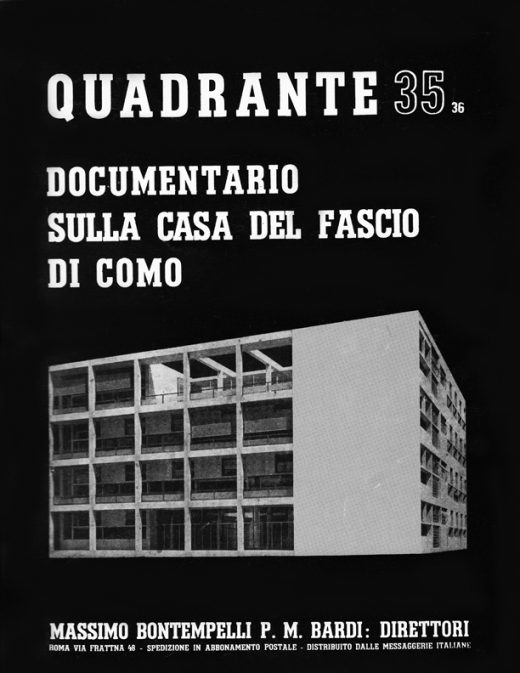
Earlier Fascist Party headquarters had been modeled after Mussolini’s study on Milan’s Via Paolo da Cannobio. They embodied fascism as underground movement. Terragni’s glass house sought instead to embody a vision of fascism as a light and nimble but solid and powerful corporativist state: fascism as a vigorous agent of modernization that is forever reaching out to embrace, to mobilize, and to engage the Italian masses. “The Party headquarters,” Terragni wrote, “can no longer assume the form of a den or a refuge or a redoubt; it must become instead a House, a School, a Temple.”18 The political end was a relationship of immediacy between party and masses. The material means was an architecture that seeks an ideal balance between monumental mass and transparency, between solids and voids, combining extensive glazing with rhythmic geometrical cutouts within a reinforced concrete grid, clad in glass and marble. The standard lictorial tower was absorbed into the building’s cubical mass so that the blank portion of the façade could serve as a site for projections or photomontages, identifying the building’s modernist surfaces with the face of a dictator who cast himself in the role of a radical modernizer (fig. 2).
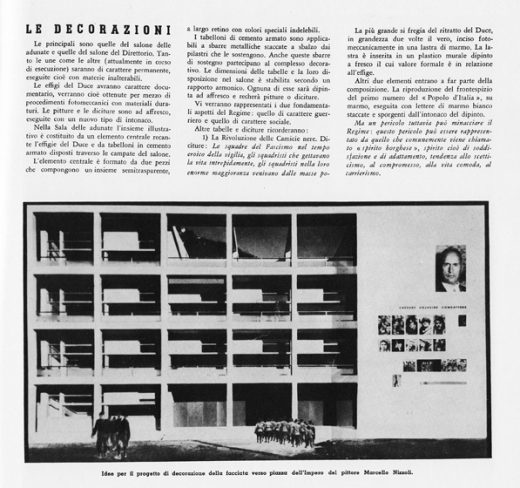
The structural frame of the building was exposed to view and its ornamentation eliminated. Inside and outside rallying spaces were interconnected visually as well as acoustically by means of a public address system to ensure that the leader could speak to his followers assembled within and still be seen and heard by crowds gathered in the piazza.19 The result was less the modest building that greets contemporary visitors to Como’s Piazza del Popolo, than a manifesto in cement, marble, steel, linoleum, and glass that advanced Rationalism’s claim to being the true architecture of the fascist revolution.20
This manifesto is largely written in industrial glass, alternating freely between effects of refraction and transparency, stagings of glass as crystalline mass and stagings of its liminal materiality. Glass bricks are featured in its ceilings, floors, and walls. Plate glass surfaces, like the mechanically actuated entrance doors that run half the length of the ground floor, perform synchronized operations of opening and closing with soldierly discipline. Seamless custom-fabricated ribbons of thick crystal spiral upward four stories along its stair parapets. Adjacent to the main glass-brick floor looms a Rationalist sacrarium with a one-ton rectangular slab of blood-red porphyry, dedicated to the martyrs of the revolution, hovering as if suspended in the air behind a freestanding plate glass wall (fig. 3).
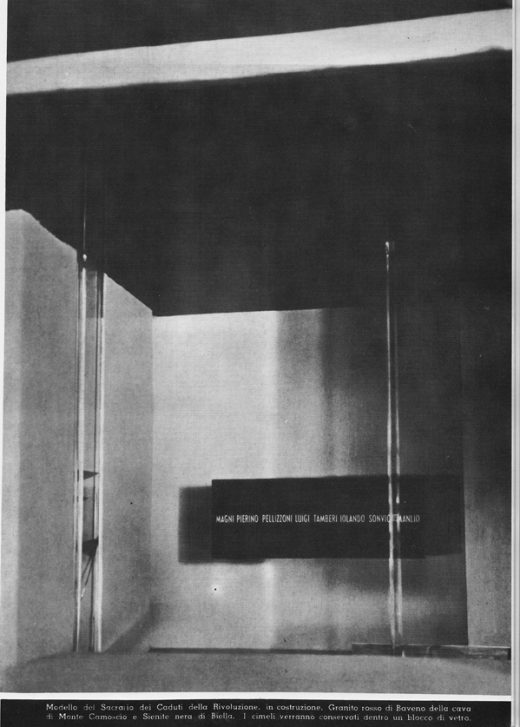
Within the sacrarium beckons a dense cubical plate glass reliquary containing the martyrs’ remains. In short, the Casa del Fascio is built upon a myriad of variations on the theme of tempered glass as the material of a secularized sacrality combining power, technics, and a higher morality. In our earlier terms, Terragni’s themes are:
• mortal glass overcome
• refractive glass elevated from mere ornament and plaything to building block of entire edifices and city blocks
• and metaglass brought down from the heavens and introduced into everyday life, itself chastened and morally uplifted by the fascist revolution.
The beliefs animating Terragni’s glass house are familiar to students of the modern movement: the identification of glass architecture with rationality, natural luminosity, airiness, honesty of thought and feeling, hygiene and health, and the democratization of comfort. Terragni throws in a few distinctive ideological twists, like his notion that the Casa del Fascio’s glass skinning enables “instinctive verification” between the citizenry and the state; and that plate glass is at once ultramodern and a distinctively Italian autarchic material with ancient Roman roots (fig. 4).21
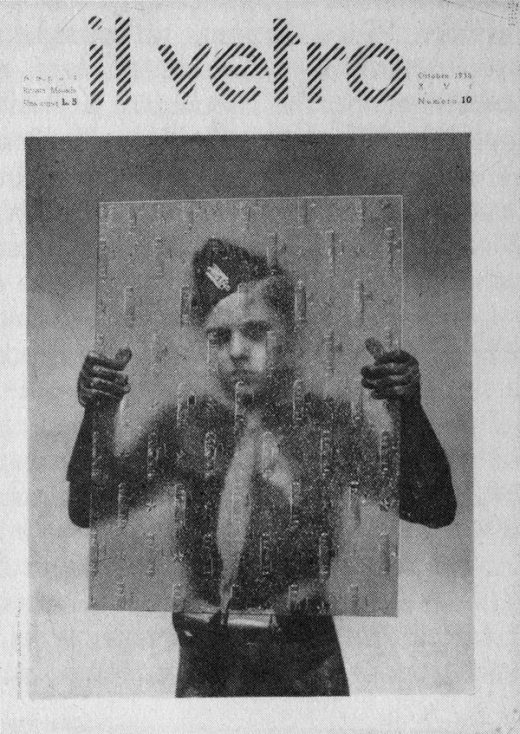
Reviews like Il vetro, the official publication of the Fascist Association of Glass Manufacturers, preached precisely the same gospel of modernità as italianità.22 But even when the equation was made explicit in cover images like the one that graced Il vetro’s tenth issue, in which a fascist boy scout gazes out through a fasces-embossed pane of glass, the youth’s sullen gaze and the hazy cast of the pane hint that Mussolini’s regime was proving anything but luminous and transparent. This Terragni was experiencing on a daily basis even during the construction of the Casa del Fascio, though ever the true believer he retained his party card right up to his death in 1943, which followed on the heels of his return from the Russian front.
Political loyalties aside, Terragni’s endeavors remain of a piece with the dreams of an aerial architecture and civilization variously propagated by men like Le Corbusier, Gropius, Wright, Bel Geddes, and 1930s futurists, and present in seminal works from Mies’s 1922 Glass Skyscraper to Bernard Bijvoet’s Maison de Verre (1928–1932) to Philip Johnson’s 1949 New Canaan Glass House.23 In a more overtly metaphysical guise, the lineage harks back to Bruno Taut’s “Crystal Chain” circle. For Taut (alias Glas), glass is “the material of brilliance”24 that opens up man-made structures to interpenetration with their environment to such a degree that the Kristallhaus emerges as a transfigured extension of nature, an artificial crystal that amalgamates with Alpine crystal formations. Most famously, the myth animates Paul Scheerbart’s Glasarchitektur, which had envisaged the advent of “a new glass culture” and “a new glass environment [that] will completely transform mankind.”25 Scheerbart authored four inscriptions for Taut’s Glass Pavilion at the 1914 Werkbund exhibition: “Colored glass destroys hatred”; “Without a glass palace life is a burden”; “Building in brick only does us harm”; “Glass brings us a new era” (fig. 5).26
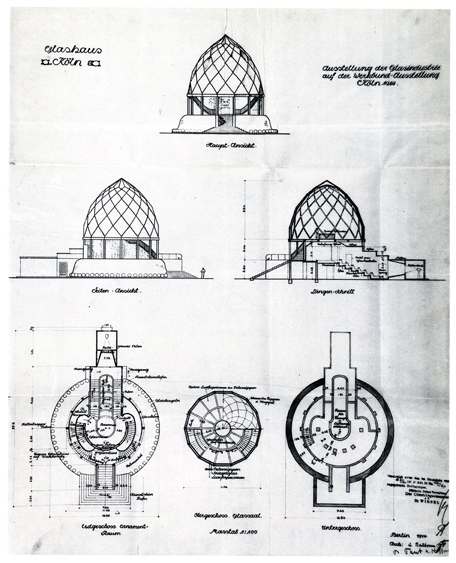
The crystal palaces of the prior century ensured the widespread currency of such ideas long before the fragility barrier was fully overcome—whether actual structures like the various London or Paris winter gardens and indoor arcades, or their utopian twins—Fourier’s glass-covered arcades, Loudon and McIntosh’s greenhouses, and Paxton’s “Great Victorian Way.” Artificial paradises all, they sought to gather under a single unifying bell jar the entire universe of plants or commodities in a setting characterized by novelty and perpetual abundance, immune to weather and processes of generation and corruption. In short, whether draped in a rhetoric of nationalism, functionalism, social reform, or chiliasm, industrial plate glass was from early on the object of a kind of secularized theology of glorified bodies within the modern architectural imagination.
It is within this setting that one of the most remarkable projects of the Italian 1930s comes into sharper focus: the Danteum (fig. 6).
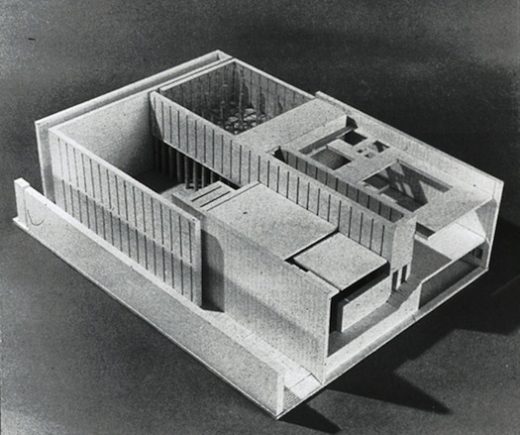
Commissioned in 1938 but never realized, Terragni imagined the edifice in question “not [as] a museum, nor palace, nor theater, but [as] a Temple”:27 a temple that would permit Italians of the Mussolinian era to relive Dante-pilgrim’s journey by traversing a series of “rooms integrated to gradually prepare the visitor for a sublimation of matter and light,”28 and to do so within a setting where Dante’s imperial dreams could be seen as part of a continuum, an eternal present, rendered palpable by the sight lines linking the Danteum to the Colosseum, the Basilica of Maxentius, and Piazza Venezia, along the Via dell’Impero (today Via dei Fori Imperiali). In pursuing these aims, the architect stripped Dante’s narrative down to its barest possible essentials so as to insist that the pathway provided the visitor is not just Dante’s, but rather our own: il cammin di nostra vita (the path of our lives). The path in question spirals upward and outward toward empire and illumination, while the possessive adjective nostra identifies the poet’s peregrinations with those undertaken jointly by individual Italians and by the national collectivity.
So, to the prior century’s realism of fantasy—think Gustave Doré’s illustrations—dedicated to the graphic depiction of extravagant episodes from Dante’s otherworldly journey, Terragni responds with a mimesis of structure that views the sacred poem as a totality. And he does so by basing his spatiotemporal transcription of the Commedia upon the poem’s numerology, architectonics, and value shifts: its reliance upon triplets and sets of one hundred; the overall shift in the course of the poem from weight, opacity, and materiality to weightlessness, translucency, and spirit; from darkness to light; from earthward gravitation to Godward levitation.
It is the architect’s interpretation of the final realm that is of special pertinence here, particularly in its pursuit of material analogues to the Paradiso’s architecture of dematerialized bodies and in its attempt to find formal equivalents to the constant inversions of perspective between reflection and source, circumference and center, consequence and cause.
Corporeality is the third canticle’s most intractable poetic problem: a problem aggravated by the three-dimensionality of architectural form. Does Dante journey inside or outside a body of flesh and blood? And what of the cosmic medium that he traverses: does he displace it or is he coextensive with it? As in the case of the Apostle Paul, rapt to the “third heaven” in 2 Corinthians 13, such questions must necessarily be placed under erasure. They stand, nonetheless, at the heart of the scholastic theology of glorified bodies: a theology that, following Aristotle, held that the soul is the form of the body and that, therefore, death would free the human form from matter until the time when the blessed would regain their bodies, but in so agile, translucent, and perfect a form that they could be elevated through and above the celestial bodies (in an apparent violation of the universe’s physical laws).
In addressing this conundrum, Terragni took his cues directly from Dante, who, as noted at the beginning of this article, followed Ptolemy in depicting Paradise as a crystalline world. The Danteum’s Paradise, accordingly, is built around the thirty-three glass pilotis that complete the Danteum’s set of one hundred columns, each recalling one of the hundred cantos that compose the Comedy. Functioning as relays to a celestial kingdom entirely “free from subjection to bodily weight” (“svincolato dalla schiavitù del peso”), the glass columns also extend the thirty-three stone columns beneath them that form the ground floor entrance: the “dark wood” where the visitor’s journey begins at the Danteum’s lowest level. They rest upon stone squares but could be said to support “nothing”: the sky, an empty steel grid structure above, abstract geometries. (The renderings all have this wrong.)
Through the glass pilotis, in other words, the heavy Roman travertine world of colonnades, floors, and walls, present in the Danteum’s entryway, Inferno, and Purgatory, and in the building’s surrounding environment, begins its metamorphosis into transparent and terse glass as a stop along the road to freedom from material bonds (fig. 7).
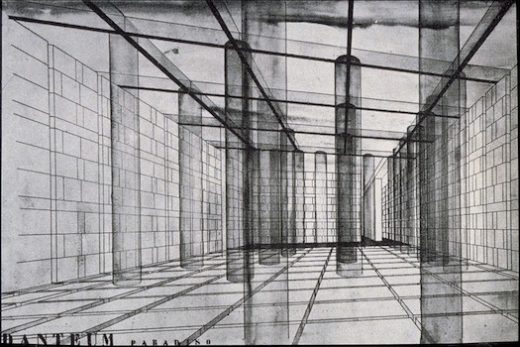
The move from body-bound gravity to disembodied levity is accompanied by a shift from a geocentric to a theocentric perspective, effected through the play of reflections between the open ceiling grid above and the floor’s glazed gridlike openings. The glass columns can serve as the fulcrum of this reversal since, unaccompanied by pediments or capitals, they offer no clue as to whether they are being viewed upside down or right side up. They thus invite reflection upon the specular relation between celestial model and terrestrial double. And, in the process, they draw the visitor’s gaze from the rapidly dwindling material ground upon which he or she stands and up toward a culminating face-to-face vision of God as a grid or the grid as God.
Twentieth-Century Case Study # 2: The Brilliant Career of the Man of Glass
The figure with whom this essay concludes was born amid this climate of excitement regarding glass-skinned buildings and dreams of utopic fusions between inside and outside, private and public, as well as dystopian fears regarding what such fusions might actually imply. His name is Gläserne Mensch—Glass Man—also known as Transparent Man (see fig. 9).29
Glass Man is an avatar of Mass Man. He arises at the end of a half century of efforts to bring the sciences of the body to the working masses, to educate them about health and hygiene, to promote the proper programming and maintenance of the body’s machinery in the name of productivity and progress, and to model regimented ideals of collective individuality, stripped of corporeal or psychic anomalies and aligned with the values of science. From the start, these efforts assumed the form of events like the 1883 German General Exhibition for Hygiene and Safety, at which advances in bacteriology were touted alongside designs for worker housing, public baths, ice machines, and Nestle’s first synthetic substitutes for mother’s milk. Attended by nearly a million visitors, the exhibition soon gave rise to the foundation of a permanent Berlin Hygiene Museum. There were telling initiatives from the private sector as well: AEG, noted for the presence of one of the founders of the Deutsche Werkbund, Peter Behrens, a pioneer in his application of glass architecture to AEG’s production facilities, established a museum of its own, filled with life-size models illustrating the virtues of fitness and good nutrition and the consequences of injury and disease.
Hygiene exhibitions were characterized by a high degree of innovation as regards installation design, and would eventually include the use of graphics, photography, new projection techniques (slides and film), sound, and light.30 Such was already the case with Karl August Lingner’s 1903 Volkskrankheiten und ihre Bekämpfung (Popular illnesses and ways of combating them) show in Dresden, where the dialogue between enlarged models of bacteria and visitor-viewable microscopes of living cultures excited and amazed nearly a quarter-million spectators. Lingner was more than an exhibition designer/promoter, enemy of germs, and champion of hygiene. He was the co-founder of the Odol company, Europe’s leading mouthwash and toothpaste brand, and a dedicated believer in scientific management techniques and mass communications. Lingner’s innovative use of poster campaigns to build a mass market for Odol was carried over to the promotion of his hygiene exhibition, which traveled to Frankfurt and Kiel, always to considerable popular acclaim.31
Lingner’s reliance upon advertising campaigns, two- and three-dimensional displays, working machines, and experiential exhibits carried over into the next epochal event: the 1911 Dresden International Hygiene Exhibition, with thirty participating countries and nearly one hundred purpose-built pavilions. Here the stars of the show were the translucent organs of Der Mensch: actual human organs, dehydrated, stabilized by means of chemical agents, and transformed into gossamer structures thanks to the chemical wizardry of Werner Spalteholz. Hovering on the edge of transparency, alternately tinted or clear, suspended, and backlit, these glassy, ghostlike, scentless viscera did not elicit among the 5.2 million exhibition visitors any of the revulsion induced by samples in jars of formaldehyde. On the contrary, in them visitors saw an image of overcoming: a bright new glassy paradisiac flesh preserved by science and produced by modern techniques of installation and lighting design.
Fast-forward fifteen years, and the Dresden exhibition had matured into a permanent institution, the German Hygiene Museum, to be housed in a new facility so as to complete the experiments in mass education begun in 1903 and 1911. The centerpiece of the effort was the construction of a campus of modernist buildings, 128,000 cubic meters’ worth of built space, designed by the architect Wilhelm Kreis, including exhibition galleries, a covered courtyard, a congress hall, and a landscaped park also housing Dresden’s earliest baroque buildings. The facility was outfitted not only with door fixtures by Walter Gropius but with state-of-the-art drafting and photography studios, a model-building lab, and a machine shop (fig. 8).
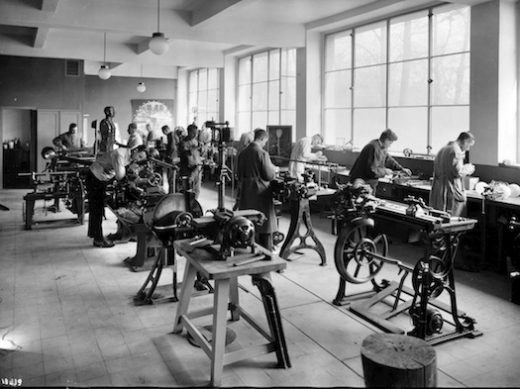
The hall devoted to Der Mensch is placed where the building’s main axes intersect, and the chapel dedicated to the museum’s focal point, Glass Man, is situated at the center of that central crux. Construction began in 1926; opening day was scheduled for May 16, 1930, with Glass Man cast in the starring role right from the start.
The years between the 1911 exhibition and the opening of the new Dresden Hygiene Museum were not wasted by Lingner’s circle. They permitted the museum’s main preparators, Franz and Fritz Tschakert, to hone their skills as makers of transparent, electrically illuminated models and to explore new methods of molding, pressing, blowing, milling, drilling, and assemblage. To this end, the Tschakerts had fabricated clear sections of the human body as well as specific organ complexes for a number of intervening exhibitions between 1911 and 1926. Starting in early 1926, they brought these experiences to bear on the production of their first full-scale body. The museum labs weren’t yet available, so they set up shop at the production facilities of Siemank und Ringelhahn, a Dresden confectioner, to take advantage of the company’s industrial steam lines, molds, and presses. There they built a being known as Jumbo during the time of his construction.
Starting from an actual human skeleton that was selected for its statistically “average” physical features, the Tschakerts artfully wired together a standing figure in the orant pose: a pose associated with prayer in pagan antiquity, transformed into the sacramental gesture of the priest at the altar by early Christians, but here restored to its classical nudity with a nod in the direction of contemporary naturism and sun worship (fig. 9).
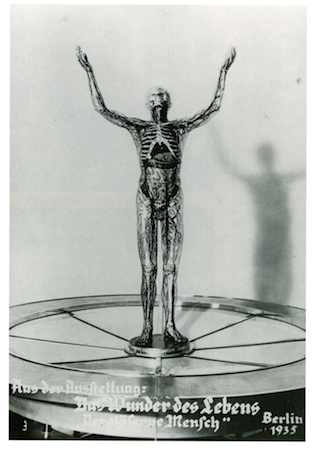
The immediate model was Boidas’s fourth century BCE Praying Boy, a statue formerly in the possession of Frederick the Great (fig. 10).
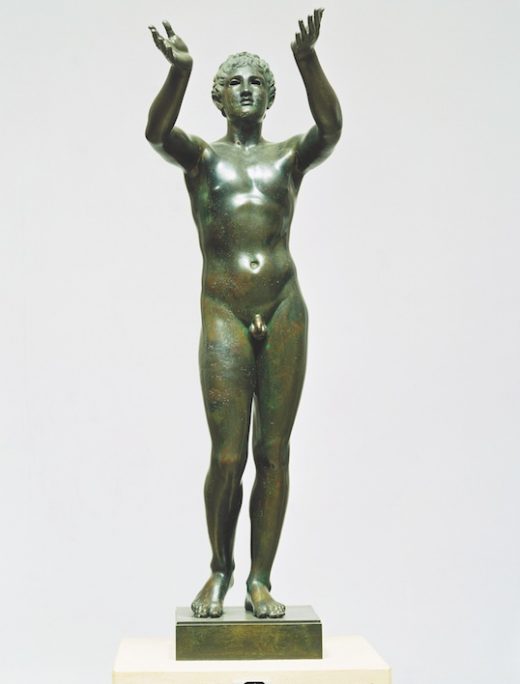
The contours of Jumbo’s body were built out with wood shavings overlaid with dehydrated gypsum (plaster of Paris), sculpted to classical proportions, and employed to prepare a set of interlocking metal molds. Each mold was fitted with a pressurized lid that allowed the casting material to be shaped under heat and pressure. A water-cooling process would ensue, followed, in turn, by the extraction, cutting, polishing, and assemblage of the units so produced. Jumbo’s organs were manufactured by means of wax models and realistically painted. His circulatory and nervous systems were built up around networks of wires and tinted red (for arteries), blue (for veins), and green (for nerves). An internal system of illumination was developed to allow for the highlighting of specific features and clusters (fig. 11a, b).
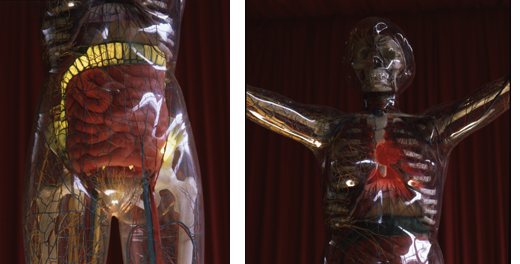
By mid-1927, Jumbo was fully assembled. He was transferred to the museum laboratory for completion and presented to the board of trustees under the banner “Man as a Prime Example of Technical Perfection.” Patents were sought before he made his 1930 debut on the world stage.
The branding of Glass Man as a “prime example of technical perfection” recalls Karl August Lingner, whose belief in fighting germs with Odol products was informed by an overall understanding of the human body as a hierarchically organized factory within which the smooth functioning of organs and circulatory flows was the prerequisite for health, which is to say, productivity. It also anticipates two subsequent crystalline representations of other sorts of complex productive systems, no less utopic than Terragni’s glass palaces: an Auto Union transparent engine and a six-meter-tall, three-thousand-pound transparent factory. Both were built in 1938 by the German Hygiene Museum and exhibited to mass audiences (fig. 12).
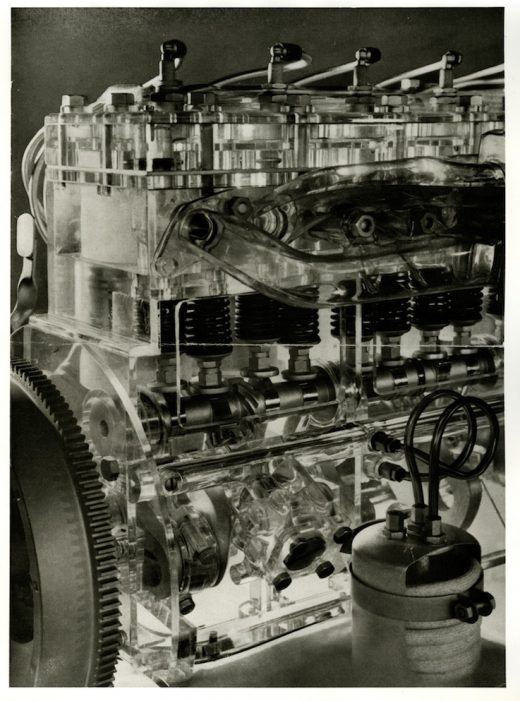
Together these objects form a cohesive whole based upon a structural homology enabled, in turn, by the availability of transparent shell materials: namely, the dream of a society in which well-designed and -governed motors, men, and factories form a single crystalline whole. That such a corporate body might extend further outward to encompass the state and even the nation seemed plausible not only to positivists like Lingner, Bauhäusler like Herbert Bayer, and National Socialists, but also, as we will soon see, to American champions of liberal democracy, private enterprise, and social eugenics, as well as to health ministries throughout the Soviet bloc (fig. 13).
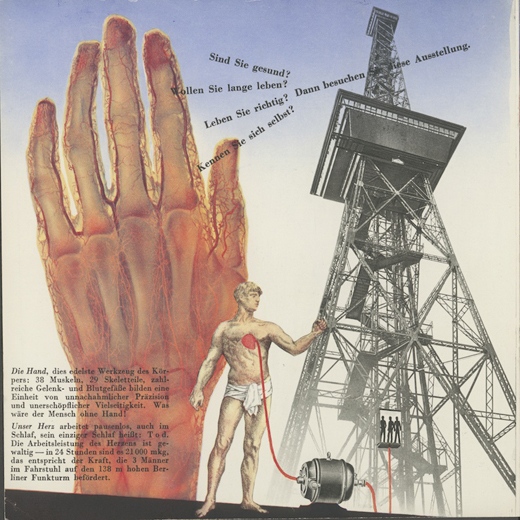
Though he began life as a solitary showman, fabricated by means of industrial processes, Glass Man was, from the start, a multiple. And multiply he did in wake of the acclaim that greeted him when the German Hygiene Museum opened its doors. By 1933, a second Glass Man had been manufactured for the Mayo Clinic in Rochester, Minnesota, and was promptly sent off to serve as the centerpiece of the Hall of Science at the Century of Progress exhibition in Chicago. In 1934, a third figure surfaces as the star of a touring exhibition titled Eugenics in the New Germany. He eventually landed at the Buffalo, New York, Museum of Science where he remained for several decades, aside from a stint at the New York World’s Fair of 1939. A fourth figure was produced for a 1936 Stockholm exhibition on mothers and children. It was then transferred to Paris and featured at the 1937 Exposition des arts et des techniques, where it drew such overflowing crowds that the gates had to be kept open until midnight every night.
Gläserne Mensch’s crossing of the Atlantic bore several consequences, among them an increasing emphasis on transparency over glassiness as a descriptor, and a commercial twist. The most significant outcome was the birth of a companion: a Gläserne Frau (fig. 14) produced by the Tschakerts at the then-staggering cost of $20,000.32 The idea seems to have originated with the American industrialist S. H. Camp, founder of Camp Scientific Corsets, who commissioned and took delivery on the first Woman of Glass in 1936. Camp’s ambitions were at once promotional and educational (fig. 15).
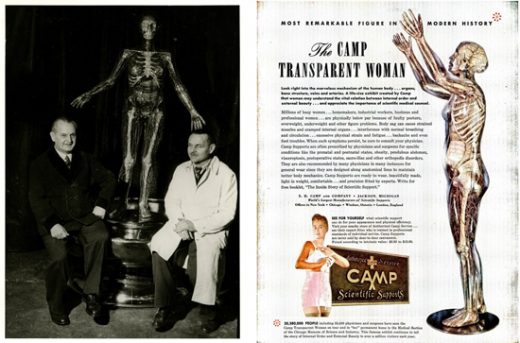
Fig. 15 (right). “Camp Transparent Woman,” advertisement, Life, May 8, 1950.
The so-called Camp Transparent Woman arrived in North America in late August 1936 and was installed for two months at the Museum of Science at Rockefeller Center before embarking on a decade-long nationwide tour accompanied by a doctor-lecturer, becoming a standard feature in Camp’s advertising campaigns. By 1950, Camp could claim that she had been seen by 20,380,000 people, including 55,000 physicians. Other transparent men and women were fabricated during the war years and went on to tour postwar Germany and Eastern Europe. Their story is tangled, but here is one highlight: in December 1949 a transparent couple was delivered to the self-designated man of steel, Joseph Stalin, as a seventy-first-birthday gift by the Society for (East) German-Soviet Friendship.33
In summary, in the course of twenty-five years, Glass Man and Glass Woman reached audiences numbering well into the tens of millions. Perhaps as many as fifty were created in total in the Tschakerts’ lab, alongside transparent horses, cows, and dogs (fig. 16).
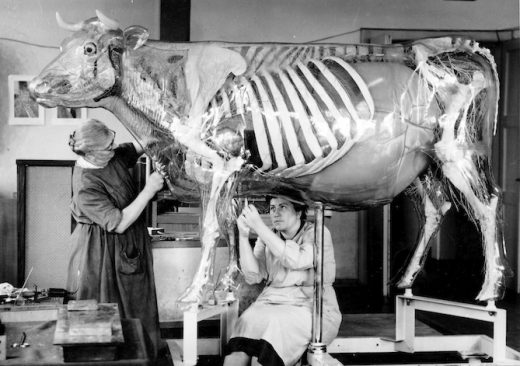
They became consecrated symbols of the Health Museum movement, worldwide messengers of Scheerbart’s “new glass environment [that] will completely transform humankind,” the model citizens of the glass utopias of the day and bearers of ideas that overleapt ideological barriers and even the wall of a catastrophic world war. Apart from a brief interruption, the German Hygiene Museum remained open during this period. Fully restored, it is open to this day and continues to feature a Man of Glass and Woman of Glass, now critically framed within its own institutional history. But these hybrids of Vitruvian and Vesalian humanity wrapped up in an industrial-age container harbor a secret (or, rather, I have withheld one on their behalf). Our crystalline friends, from Jumbo to Stalin’s Glass Couple, were not manufactured out of glass at all, but instead out of a celluloid-like material related to Cellophane and derived from acetylcellulose (but without celluloid’s flammability), known as Cellon.
Fabrication in glass was indeed attempted as far back as 1911, when an enlargement of the Boidas Praying Boy sculpture failed because of issues of scale, friability, and fragility.34 In the intervening decade early sheet plastics like Cellon came along and made possible the realization of Lingner’s dream—but in plastic, not glass. Why didn’t the headline change from The Glass Man—A Sensation to The Miracle of Modern Plastics? Language was not a factor, for German, French, and English do not rely upon glassy as their adjective to communicate transparency. As I hope has become clear in the course of this article, deeper motives are at play.
Plastics were new. They had no history or identity of their own. They were flammable, unreliable, poor cousins, viewed as imitative with respect to glass, wood, cloth, tortoiseshell, and even vulcanized rubber.35 Glass was instead a noble historical material whose greatest limitation had only recently been overcome through a triumph in modern manufacturing techniques. So it was a cultural logic that dictated that the skin of a new humanity be made of industrial-era glass rather than plastic in order to maintain a network of larger connections: between the self and the built environment, between the body and body politic, between ideals of health, openness, and moral transparency. An upstart in the world of modern materials, Cellon proved far more malleable than the tenacious coupling between the metaphor of transparency and a material freighted with powerful old and new meanings. Only in the United States in the later 1930s did the first glimmerings of a second narrative begin to surface here and there: of better things for better living through modern chemistry, of plastics as the true skin of modern life or of a future society of plenitude, pleasure, and consumption.
But it is Cellon that will have the last word. For Cellon, being made of cellulose acetate, has one major defect: like human skin, but unlike glass, it ages; it yellows and, in the process, gradually loses its crystalline transparency (fig. 17).
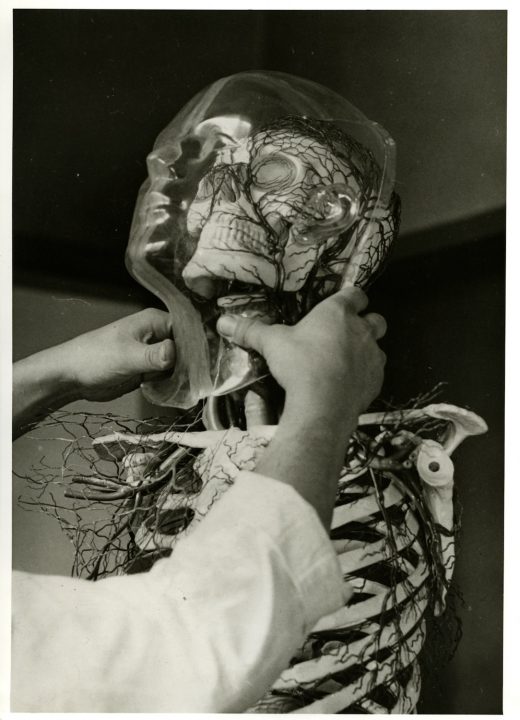
Freshly minted, the Man of Glass and Woman of Glass were dressed in shells that adequately replicated the optics of industrial glass. So it hardly stretched the imagination of 1930s audiences to perceive them as vitreous bodies. As they toured the world, however, the Cellon began to talk back. And the story it told was cast in the language of yellowing plastic.36
Jeffrey T. Schnapp is the faculty director of metaLAB at Harvard University, where he teaches in the Department of Romance Literatures and Languages, as well as at the Graduate School of Design. His most recent books are Modernitalia (Peter Lang, 2012) and Digital_Humanities (with Anne Burdick, Johanna Drucker, Peter Lunenfeld, and Todd Presner; MIT Press, 2012). Forthcoming in 2014 is The Library beyond the Book (Harvard University Press).
- 1. Maxime du Camp, Les chants modernes (Paris: Bourdilliat, 1860).
- 2. This chapter has been published as “The Romance of Aluminum and Caffeine,” Critical Inquiry 28.1 (Fall 2001): 244–69 (special issue on “Things/Objects,” ed. Bill Brown).
- 3. A compressed version is in “Domes to Domus (or How Roberto Mango Brought the Geodesic Home to the Home of Italian Design),” in Rethinking a Century of Italian Design, ed. Kjetil Fallan and Grace Lees-Maffei (London: Peter Berg, forthcoming).
- 4. My favorite recent study on this topic is Stephen L. Sass, The Substance of Civilization: Materials and Human History from the Stone Age to the Age of Silicon (New York: Arcade, 1998).
- 5. See A. L. Oppenheim, R. H. Brill, D. Baraga, and A. von Saldern, Glass and Glassmaking in Ancient Mesopotamia (Corning, NY: Corning Museum of Glass Press, 1988). For a panoramic history of glass as a material, a good point of departure is Chloe Zernick, Short History of Glass (Corning, N.Y.: Corning Museum of Glass Press, 1980).
- 6. Thomas Bancroft, The First Booke of Epigrammes (1633–1658) (London: Printed by I. Okes for Matthew Walbancke, 1639), 9.
- 7. The most significant cases in point seem to date from the sixteenth through the nineteenth century, the period when glass production gradually moves out of the craft workshop into the factory. They appear to be concentrated in northern and central Europe. Among them, worth singling out are “The Glass Coffin,” included in the Brothers Grimm, Household Tales; “The Glass Man and the Golden Bird,” one of the Hungarian folktales published in The Glass Man and the Golden Bird, retold by Ruth Manning-Sanders (New York: Roy, 1968); and “The Glass Mountain,” a Polish tale variously redacted and available at http://www.mythfolklore.net/andrewlang/031.htm.
- 8. All references to Cervantes’s text are to Miguel de Cervantes Saavedra, Obras completas, 2 vols. (New York: Las Americas, 1964). On Cervantes’s sources and the family of texts to which the novella belongs, see Gill Speak, “El Licenciado Vidriera and the Glass Men of Early Modern Europe,” Modern Language Review 85.4 (Oct. 1990): 850–66.
- 9. The original reads: “por ser hombre de vidrio y no de carne: que el vidrio, por ser de materia sutil y delicada, obraba por ella el alma con más promptitud y eficacia que no por la del cuerpo, pesada y terrestre.” Cited from Obras completas, 2: 225.
- 10. Cases in point are the two versions of an article taken from the London Globe entitled “The Man of Glass,” published in the New York Times (Feb. 12, 1881), 3, and the Detroit Free Press (Feb. 20, 1881), 4.
- 11. Emanuele Tesauro, Il cannocchiale aristotelico o sia idea dell’arguta et ingeniosa elocutione che serve a tutta l’arte oratoria, lapidaria et simbolica (Turin: Barolomeo Zavatta, 1670).
- 12. The interplay between shifts in the production methods and clarity of mirrors and a broader set of cultural shifts in the direction of humanist values has been insightfully examined by Rayna Kalas, “The Technology of Reflection: Renaissance Mirrors of Steel and Glass,” Journal of Medieval and Early Modern Studies 32.3 (Fall 2002): 519–42.
- 13. “quasi con due ali di vetro,” Il cannocchiale aristotelico, 228.
- 14. “quali per vetri trasparenti e tersi” (Par. 3.10); but see other similar references such as “come in vetro, in ambra od in cristallo raggio” (Par. 29.25); and “se il Cancro avesse un tal cristallo, L’inverno avrebbe ” (Par. 25.101). Cited from Dante Alighieri, La Divina Commedia, testo critico stabilito da Giorgio Petrocchi (Turin: G. Einaudi, 1975).
- 15. On Eisenstein’s Glass House project, see Oksana Bulgakowa, Sergey Eisenstein: Drei Utopien—Architeckurentwurfe zur Filmtheorie (Berlin: Potemkin, 1996), 109–25.
- 16. “Il fascismo è una casa di vetro, nella quale tutti debbono e possono guardare. Guai a chi approfitta della tessera o indossa la camicia nera per concludere affari che altrimenti non gli riuscirebbe di condurre a termine.” Ai gerarchi milanesi (Rome, July 10, 1929). These words are frequently echoed in the special issue that Quadrante devoted to the Casa del Fascio in October 1936; see, for instance, Carlo Belli, “Dopo la polemica,” Quadrante 35/36 (Oct. 1936): 4.
- 17. I have written at some length on this subject in “The People’s Glass House,” South Central Review 25.3 (Fall 2008): 45–56, and “Un tempio moderno” [on the Danteum project], in Giuseppe Terragni: Opera completa, ed. Giorgio Ciucci, Triennale di Milano (Milan: Electa, 1996), 267–79. On Terragni in general, there are been numerous significant studies from the past decades, among them Ada Francesca Marcianò, Giuseppe Terragni—Opera completa 1925–1943 (Rome: Officina Edizioni, 1987); Giuseppe Terragni, Opera completa, the catalogue of an important show at the Triennale just alluded to; Enrico Mantero, Civiltà di Terragni: Ricerche e scritti: 1966–2001 (Como: Nodo Libri, 2005); and most recently, Antonino Saggio, Giuseppe Terragni: Vita e opere (Rome-Bari: Laterza, 1995). On the Casa del Fascio specifically, I recommend the meticulous work of Sergio Poretti, La casa del fascio di Como (Rome: Carocci, 1998).
- 18. “Cos’è una casa del fascio,” Quadrante 35/36 (Oct. 1936): 14.
- 19. Thomas L. Schumacher, Surface and Symbol: Giuseppe Terragni and the Architecture of Italian Rationalism (New York: Princeton Architectural Press, 1991), 143.
- 20. That it was understood as such is confirmed by the tortured saga of the Casa del Fascio’s façade, most recently examined in Luciano Caramel, “Le decorazioni di Mario Radice e Marcello Nizzoli per la Casa del Fascio di Como di Terragni,” in L’Europa dei razionalisti: Pittura, scultura, architettura, ed. Luciano Caramel (Milan: Electa, 1989), 78–89. On this topic see also Albreto Artioli, Giuseppe Terragni: La Casa del Fascio di Como—Guida critica all’edificio (Rome: Betagamma, 1989).
- 21. “Il vetro,” Quadrante 35/36 (Oct. 1936): 46.
- 22. It is worth noting that Il vetro was edited by Pietro Maria Bardi, one of the co-founders of Quadrante, and the moving force behind the October 1936 special issue devoted to the Como Casa del Fascio.
- 23. The topic has been exhaustively studied in the field of architectural history, particularly with reference to seminal figures like Mies. A good point of entry is Georg Kohlmaier and Barna von Sartory, Das Glashaus: Ein Bautypus des 19. Jahrhunderts (Munich: Prestel, 1981), and Reyner Banham’s brief essay “The Glass Paradise,” in A Critic Writes: Essays by Reyner Banham, ed. Mary Banham, Paul Barker, Sutherland Lyall, and Cedric Price (Berkeley: University of California Press, 1996), 32–38. But with special reference to Mies, see also Franz Schulze, Mies van der Rohe: A Critical Biography (Chicago: University of Chicago Press, 1985), 100–103, 141–43.
- 24. Iain Boyd Whyte, ed. and trans., The Crystal Chain Letters: Architectural Fantasies by Bruno Taut and His Circle (Cambridge, MA.: MIT Press, 1985), 25.
- 25. Paul Scheerbart, Glass Architecture, published in joint volume with Bruno Taut, Alpine Architecture, ed. Dennis Sharp, trans. James Palmes and Shirley Palmer (New York: Praeger, 1972), 74.
- 26. On the beliefs animating Taut’s work, see Rosemarie Hagg Bletter, “The Interpretation of the Glass Dream—Expressionist Architecture and History of Crystal Metaphor,” Journal of the Society of Architectural Historians 40.1 (Mar. 1981): 20–43.
- 27. Cited from Terragni and Lingeri’s Relazione, reprinted and translated in Thomas L. Schumacher, The Danteum: A Study in the Architecture of Literature (Princeton, NJ: Princeton Architectural Press, 1985), 125–26.
- 28. Schumacher, The Danteum: A Study in the Architecture of Literature, 126.
- 29. The most exhaustive studies of the Glass Man and Woman are Rosmarie Beier and Marin Roth, eds., Der Gläserne Mensch—Eine Sensation: Zur Kulturgeschichte eines Ausstellungsobjekts, Deutsches Historisches Museum (Stuttgart: Gerd Hatje, 1990), and Klaus Vogel, “The Transparent Man—Some Comments on the History of a Symbol,” in Manifesting Medicine: Bodies and Machines, ed. Robert Bud (London: Science Museum, 2004), 31–61. I am indebted to both in this portion of the present essay.
- 30. Vogel is particularly good on this subject. See esp. “The Transparent Man,” 34–40.
- 31. On Lingner’s career, see Ulf-Norbert Funke, Karl August Lingner: Leben und Werk eines sächsischen Großindustriellen (Munich: Grin-Verlag, 2007).
- 32. Jill Fields has discussed this figure in her chapter on “The Invisible Woman,” in An Intimate Affair: Women, Lingerie and Sexuality (Berkeley: University of California Press, 2007), 174–216.
- 33. The episode is described in Vogel, “The Transparent Man,” 53.
- 34. Bruno Gebhardt, “Art and Science in a Health Museum,” Bulletin of the Medical Library Association 33.1 (Jan. 1945): 45.
- 35. Of the various histories of plastics that have been published over the past decades, I favor Jeffrey L. Meikle, American Plastic: A Cultural History (New Brunswick, NJ: Rutgers University Press, 1995).
- 36. A coda: the phrase glaeserner Mensch has left an indelible imprint on the cultural memory of Germany and postwar German social science. It has resurfaced over recent decades with specific reference to information-age dreams and anxieties regarding the quantified self, the self whose identity assumes the form of a data halo in the guise of clicks, searches, and log-ins. (See, for instance, Christoph Zoller, Der Gläserne Mensch in der heutigen Informationsgesellschaft: Vom Datenschutzgesetz bis zur Vorratsdatenspeicherung [Munich: Grin-Verlag, 2012]; Edith Huber, Der Gläserne Mensch—Europäisierung [Vienna: Bohlau 2004]; and Timo Bunger and Matthias Block, Der ‘Gläserne Mensch’ [Munich: Grin-Verlag, 2004].) As Glass Man fades and yellows, he is reborn as Man in the Age of Google.
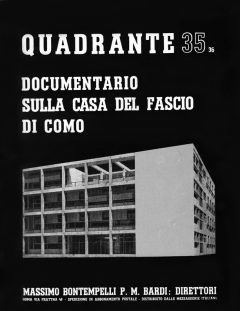
Cover of Quadrante 35/36 (Oct. 1936), special issue dedicated to Giuseppe Terragni’s Casa del Fascio in Como. Author’s collection.
